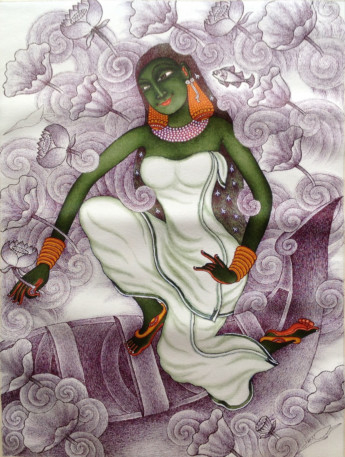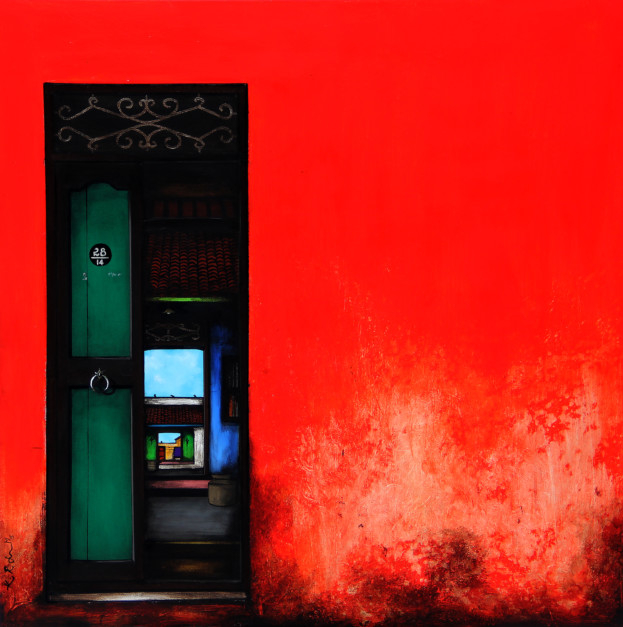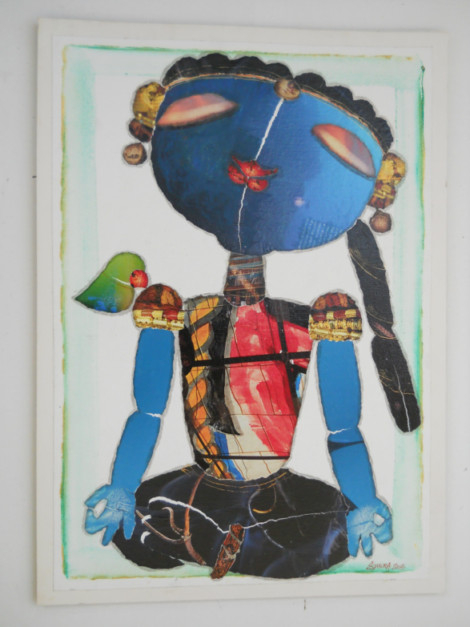
India’s artistic traditions are an enduring testimony to the country’s long history and the evolution of practices here through the ages. A show in Abu Dhabi, held earlier this month, captured the spirit, the rich visual arts heritage of the nation.
G. Subramanian, fondly called Subra, is an artist who has traversed many routes — pen and ink drawing infused with typical calligraphy, intricately woven with myth and tradition. He brings a series of collages that are constructed reinterpretations of images and text from magazines. The puppetesque icons in his works have a childlike naiveté, while retaining Indian iconography. The abstract background highlights these complex visuals.
The artist has won several awards and held many solo and group shows in India and abroad.
“Without art, life is empty,” says Subramanian, who draws inspiration from the colourful costumes his father wore for theatre performances, but his work is dipped in his own pain following the loss of his only daughter to cancer.
He went on a spiritual journey in search of answers, but his life seemed distant and blurry. This melancholy was broken when he won a gold medal in an art competition. Soon after, he visited the Sistine Chapel in Italy. There, as he stood looking at Michelangelo’s works, it came to him like a bolt from the blue. He found his path to a whole new meaning and genre of decorative art.
“I started working on images of gods, goddesses, birds and flowers such as the lotus. The smiling face of my daughter always finds a place in my art. She loved birds, and the parrot was her favourite. In many of my paintings you can see a young girl holding a parrot. Today the inspiration and spirit behind my art is the memory of my daughter’s smile,” says Subramanian, who used to take weekend art classes for children.
Some subjects come naturally to him. “Mythological images such as the Buddha, Ganesha, Krishna and Saraswati come from my childhood memories. Like any other child in India or elsewhere, I too have grown up listening to stories narrated by elders. And they have found a way into my art.”
Subramanian’s colourful collages come with signature decorative facial features and forms. He uses paper collage to assemble his thoughts, which gives it a contemporary, or a rather unique layer-texture format. “For me texture is very important and helps me connect with the viewers. I want the person looking at my art to not only understand the emotion behind it but also feel it.”
A little peek K.R. Santhana Krishnan’s work show a world behind doors
Another unique facet of his work is that he uses paper only from the “National Geographic” magazine.
Subramanian has worked and lived in the Gulf. He worked as a graphic designer in Jeddah for eight years. His works are collected internationally, with loyal collectors in countries such as the United States, Canada, Lebanon, Saudi Arabia, France, the UK and Austria. He has travelled extensively with solo shows.
Indian art, he observes, has ever-growing demand and market. “This is because of the country’s diverse and rich culture as well as a strong arts heritage.”
Wall of fame
It’s rather hard to miss Suresh Muthukulam’s imposing mural at Mumbai airport’s new terminal T2. His works on show in Abu Dhabi have his signature and unique style, in which elements of the Kerala murals are presented in a contemporary theme.
Muthukulam was only 18 when he was formally enrolled into a gurukul for mural art before studying at a fine arts college. Gurukul is an ancient form of residential schooling in India, in which pupils stayed with their guru (teacher) to learn.
“Those days, there were no institutes to teach this dying form of temple art in Kerala,” says Muthukulam of the time he joined the gurukul. “My father is truly my first teacher. He used to recite the ‘Bhagavatam’ [Hindu holy scripture] and I would visualise the characters vividly. Drawing them out was only a natural consequence. Chancing upon my sketches, my father took me to Guru Mammiyoor Krishnankutty Nair and the rest is history.”
Muthukulam was one of the first 10 students to receive the nationally recognised diploma in mural art by Guruvayur Devaswom’s Institute of Mural Painting. His portrayal of “The Last Supper” was given to the Vatican museum by the state.
Murals being quite a labour intensive technique, Muthukulam says, is why he can only produce a few works in a year. Kerala murals are frescos depicting mythology and legends, which are drawn on the walls of temples and churches in South India, principally in Kerala. Ancient temples, churches and palaces in the state display an abounding tradition of mural paintings, most of which date back to the 9th to 12th centuries when this art form enjoyed royal patronage.
The traditional mural paintings, which use natural pigments and vegetable colours, are being revived by a new generation of artists actively involved in researching and teaching this genre of art. The artists primarily use five natural hues native to the state — brick red, leaf green, blood red, white and black.
Between shows, Muthukulam teaches mural art to the new generation, and is pleased with the growing demand for the hand-painted traditional art form. The advent of gadgets, he says, does not seem to have dulled the zest of genuine art seekers who value attention to detail and the artist’s personal engagement.
Open doors
K.R. Santhana Krishnan’s critically acclaimed signature works capture more than just colourful doors from Tamil Nadu.
“My fascination for doors goes back to my childhood and student days in Kumbakonam. Growing up in the ‘agraharams’ [traditional South Indian colonies inhabited by Brahmins] and spending years there made me ponder over the different worlds that existed behind each door. The way the light fell on the threshold, the use of colours and materials for the doors and walls ... each has a tale to tell about the house, its owners and their lives. Even the surfaces of the doors have plenty to tell, if you are willing to listen,” explains the Chennai-based artist who has more than 800 works to his credit.
Most of the paintings show half-open doors that lead viewers to the scenes framed in them. The peep into the courtyards inside, milk cans at doorsteps, corridors awash with the faint glow from kerosene lamps, haphazardly arranged wooden boxes, clothes drying, or the fading white paint of numbers and letters on the doors give the onlooker a clue about the people who live behind those doors, without actually depicting them.
“Some are corporation numbers, ward numbers, electricity board connection numbers ... For instance, P26 indicates that polio drops were given to a child in the house under the government immunisation programme,” says Santhana Krishnan.
His works were a part of many recent fairs in the UAE and his solo in Singapore, too, is reported to have been a success.
Robed women
Cultural diversity and tolerance has been making national and international headlines for a while now, and this has prompted Devi Seetharam to add new works to her series of women wearing headscarves and traditional abayas.
“I have nothing typically Indian in my works. But it is relevant to India too. My works theme around the international importance of cultural diversity,” says the artist, whose monochrome works make a statement of their own.
Archana R.D. is a Dubai-based freelance journalist, a certified advanced energy healer and is known as artist B’lu.
The works were on show for sale at India House in the Indian Embassy campus, Abu Dhabi, earlier this month.
Indian Art
The origin of Indian art can be traced to the prehistoric Hominid settlements in the 3rd millennium BC. Over the ages, Indian art has had cultural influences from the Indus Valley and Hellenistic periods, as well as from religions such as Hinduism, Buddhism, Jainism and Islam. Along with this complex mixture of diverse traditions, all the major religious groups have shared the prevailing artistic style at any given time and place in the history of the country.
The holistic universe of art and culture is the common thread that weaves together Indian artists from every generation, and perhaps that’s why their art is priceless.
The ever-evolving Indian arts scene has helped change the stereotypical image of India into a vibrant country of immense possibilities. There has been a steady interest among buyers, be it ancient art and sculptures from temples, darbar art under the patronage of kings and Mogul rulers, or art during the British colonial rule and the post-independence period. Current market studies show that Indian art is witnessing exponential growth, both culturally and commercially. It is considered the fourth most buoyant art market in the world. With massive art projects in the pipeline and having officially found a place on the global art map with Art Abu Dhabi, interest in the UAE’s capital, which has now become a hub between Europe and the Western World, the Middle East and Asia, is growing. This well-timed event by the Indian Embassy can prove to be an amazing opportunity for visiting contemporary artists from the country and investors alike.















